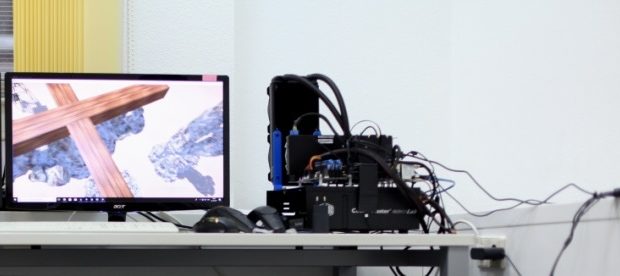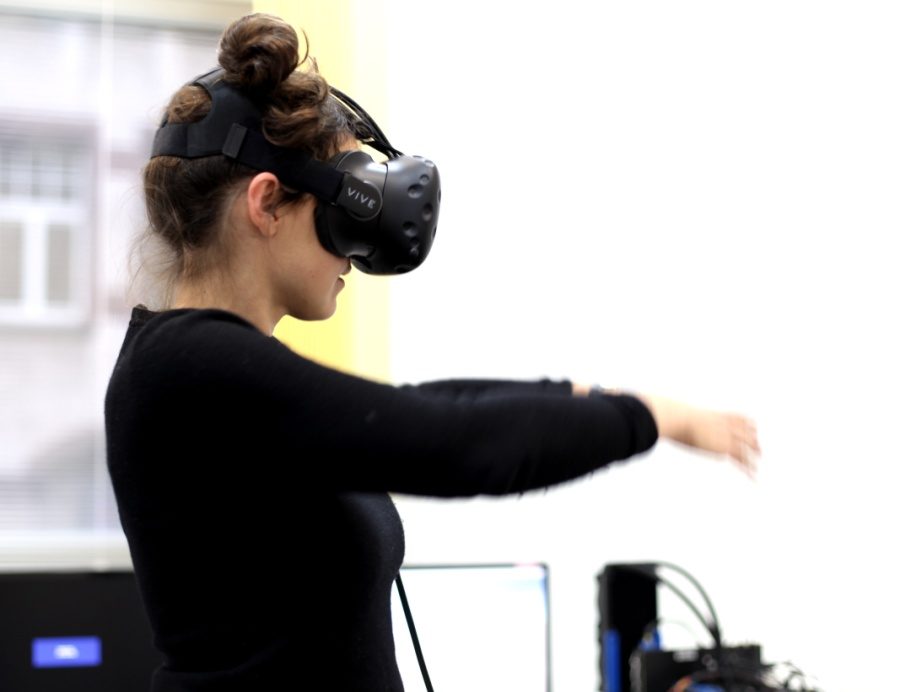
In behavioral research, it is notoriously difficult to measure authentic human behavior in the controlled setting of a laboratory. You typically have to fall back to observing minor movements, like bodily reactions, as substitutes – or you skip the human altogether and observe rodents instead. You can put rodents in situations you cannot put humans into and observe them in a controlled environment.
But what you are then measuring is rodent behavior, and you cannot be sure that your findings are applicable to humans. To understand more about how behavioral data from rodents might translate to humans, my colleagues and I have developed a human version of one of the most prominent rodent behavioral tasks in a study just published in BMC Biology – the elevated plus maze.

In situations that inflict anxiety, such as presence of threat, mammals typically adapt their behavior in a common pattern. When the distance between subject and threat is large, behaviors range from behavioral inhibition (decreased activity) to risk assessment and exploration. If the threat comes close, the subject may attack, freeze, or take flight. Which behavior an individual selects depends on the individual level of anxiety.
For decades, behavioral biologists have therefore measured the behavioral response of rodents in standardized experimental conditions to try to gauge their level of anxiety. One of the most prominent tasks is the elevated plus-maze (EPM), in which rodents are placed on a maze with two open and two closed arms, raised off the ground. Rodents tend to avoid open spaces and heights, and one marker to assess rodents’ anxiety is therefore the time they spend on these aversive open arms. Rodents with little anxiety spend more time on open arms, while rodents with high anxiety hide in the closed arms.
Psychiatric research used this task to study how drugs, genetic manipulations, and environmental factors alter anxiety in rodents. Such findings have often been considered applicable to humans, but as no comparable task was previously available, these could not be confirmed, complicating translational research.
Human anxiety can easily be observed on a behavioral level – think of someone in a dark alley, or approaching a high cliff – but hardly implementable in a laboratory.
The absence of an established behavioral task for human anxiety was puzzling to us, as human anxiety can easily be observed on a behavioral level. Just think of someone accelerating their gait in an alley at night, or hesitantly approaching a high cliff. Admittedly, such situations are hardly implementable in a laboratory situation; and a human-sized EPM in a lab also carries logistical problems and obvious safety issues. To our knowledge, no-one had ever tried to set-up such a task.
To finally be able to have the same well-established tool to measure anxiety in humans, we developed an EPM test for humans. It was important for us to measure actual human behavior, while at the same time we were aiming for a test that is usable in any average-sized laboratory without major risks to subjects or researchers.

In our EPM test, subjects stand on a 3.5m by 3.5m wooden cross, with virtual reality headsets simulating a drop of 50m off the edge of the cross (the cross is really elevated 20cm). We used a mixed reality environment: in addition to a virtual reality setup, we included real world sensations such as wind from ventilators, so that subjects can actually feel the virtual environment instead of only seeing it. It was interesting for us to see that even some of us, who developed the EPM and had never experienced acrophobia (fear of heights), instantly froze or shivered with fear when we were confronted with the virtual chasm.
We were now able to study participants’ behavior on a human EPM, and used motion tracking to analyze the behavior of more than 150 people on the EPM. Interestingly, we found that the same parameters as in rodents reflected anxiety in humans (e.g. total time on the ‘open’ arms, with the 50m drop in sight).
Psychiatric disorders manifest in two relevant domains: people’s minds and people’s behaviors. Nevertheless, the study of relevant behaviors in the laboratory has hardly been performed until now.
In our experiments, these parameters correlated with subjective anxiety ratings, with relevant anxiety-related traits, and were sensitive to drugs that selectively alter anxiety-related behaviors. Moreover, we found strong activation of the participants’ stress systems on a hormonal and physiological level, confirming that the subjects were stressed and anxious in the virtual environment. Therefore, even though participants knew that they were tested in a laboratory, their anxiety was real and their behavioral response reflected their individual level of anxiety.
We think that this behavioral task will push translational research in psychiatry. Psychiatric disorders manifest in two relevant domains: people’s minds and people’s behaviors. Nevertheless, the study of relevant behaviors in the laboratory has hardly been performed until now. For example, in anxiety disorders, avoidance of potential threats is a hallmark symptom. With the human EPM we can now quantify avoidance in the laboratory and link it to neurobiological findings.
We hope that the human EPM and other tasks that will be developed will help to better characterize relevant behavioral phenotypes in the future. Instead of questionnaires or substitutes, researchers will rely on actual human behavior. Clinical studies may include behavioral outcomes as primary endpoints in addition or instead of subjective reporting about symptoms. This said, we think with virtual reality we are approaching a new era of behavioral research in humans and the elevated plus-maze is just a beginning.
https://www.youtube.com/watch?v=_Y00eUD9fqM&feature=youtu.be
- Virtual Reality brings human behavior to the laboratory - 2nd January 2018
Comments